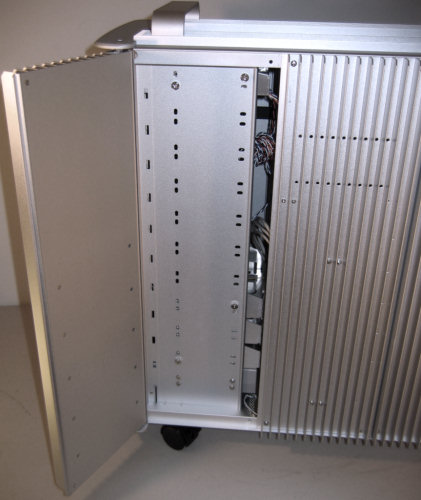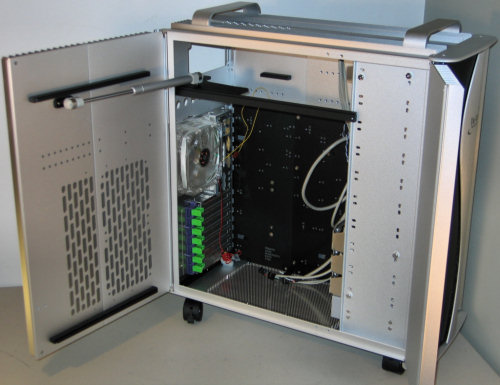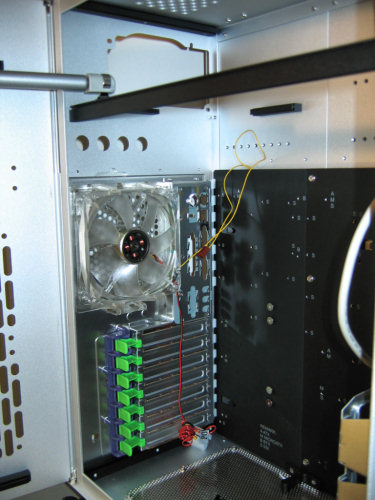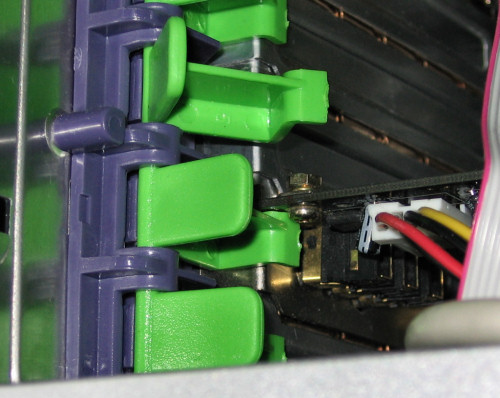Clash of the Titans - TT Tai Chi vs. CM Stacker 830
by Joshua Buss on February 23, 2006 12:05 AM EST- Posted in
- Cases/Cooling/PSUs
Thermaltake Tai Chi (cont’d)
To keep the case as tool-less as possible, Thermaltake simply chose to use thumbscrews to secure drives into the 5¼” bays. While this requires opening the right side of the chassis, there are a couple reasons why this isn't as much of a problem with the Tai Chi as it is with most cases.
First, this area of the case can open entirely on its own as shown in the picture above, which we found that it actually makes for an excellent place to hide additional cables, ensuring tidiness in the rest of the PC. More importantly, however, the Tai Chi's free-turning casters make turning the case a cinch, so access isn't as big of a deal. Two of the same large extended thumbscrews mentioned previously are used to hold this latch secure when closed.
The left side of the case is where the real attraction on the Tai Chi comes though. Here, a hydraulic arm is used to actively swing the oversized access door open, which simply consists of two of the solid passive vent-lined panels connected with the black solid aluminum bars visible in the above picture. The third panel on the left side opens as well, mirroring the panel on the right side that was just discussed.
This active opening mechanism has its own benefits and drawbacks; in using the case, the main advantage to this approach that we've found is that it stays fully open when working inside. Besides that, and the “wow factor“ of showing off the case, there's not much of a reason to incorporate the arm; especially if lots of equipment are installed to the inside of the door, a forceful opening might not be what the user desires. However, if preferred, the entire hydraulic assembly can be removed without hurting any other functionality.
The front of the case is exceptionally accessible, thanks to this dual-door design. Notice how there's another area here between the forward door and the drive bays (about one full inch in width) that could be used for any number of things. This picture is also a decent shot of the bottom mesh and motherboard tray, and also gives one an idea of how neatly they can route the cables from the top-mounted external ports, considering their plentiful length.
Focusing on the inside rear of the case, we find one of the only two main active cooling components, a Thermaltake 120mm blue LED fan. These fans move plenty of air without making enough noise to even really notice that they're on, especially if controlled to use slightly less voltage than the standard 12v.
The punch outs for 3/8” OD water tubing are also visible, as are the same tool-less expansion card locking mechanisms found on the Eclipse, which was recently reviewed by AnandTech. One frustration with this particular scheme is that they can be very difficult to unclip with certain cards. A SoundBlaster Audigy for instance made it darn-near impossible to unclip the green part in our test system due to a bolt on the card as seen here.
We'd prefer here if Thermaltake had simply opted for large thumbscrews like what other manufacturers are doing for the expansion cards. Take comfort though that this is pretty much the only complaint that we have with the Tai Chi after working with it for several days.
The spaces between the PSU area, crossbar, and motherboard assembly are all generous and, combined with the wide-opening dual doors, make working in the case a real pleasure. One last point of interest in this picture is the slots in the motherboard tray near the rear – they're not just at the bottom, indicating yet again that the case is truly designed and ready for BTX motherboards.
To keep the case as tool-less as possible, Thermaltake simply chose to use thumbscrews to secure drives into the 5¼” bays. While this requires opening the right side of the chassis, there are a couple reasons why this isn't as much of a problem with the Tai Chi as it is with most cases.
First, this area of the case can open entirely on its own as shown in the picture above, which we found that it actually makes for an excellent place to hide additional cables, ensuring tidiness in the rest of the PC. More importantly, however, the Tai Chi's free-turning casters make turning the case a cinch, so access isn't as big of a deal. Two of the same large extended thumbscrews mentioned previously are used to hold this latch secure when closed.
The left side of the case is where the real attraction on the Tai Chi comes though. Here, a hydraulic arm is used to actively swing the oversized access door open, which simply consists of two of the solid passive vent-lined panels connected with the black solid aluminum bars visible in the above picture. The third panel on the left side opens as well, mirroring the panel on the right side that was just discussed.
This active opening mechanism has its own benefits and drawbacks; in using the case, the main advantage to this approach that we've found is that it stays fully open when working inside. Besides that, and the “wow factor“ of showing off the case, there's not much of a reason to incorporate the arm; especially if lots of equipment are installed to the inside of the door, a forceful opening might not be what the user desires. However, if preferred, the entire hydraulic assembly can be removed without hurting any other functionality.
The front of the case is exceptionally accessible, thanks to this dual-door design. Notice how there's another area here between the forward door and the drive bays (about one full inch in width) that could be used for any number of things. This picture is also a decent shot of the bottom mesh and motherboard tray, and also gives one an idea of how neatly they can route the cables from the top-mounted external ports, considering their plentiful length.
Focusing on the inside rear of the case, we find one of the only two main active cooling components, a Thermaltake 120mm blue LED fan. These fans move plenty of air without making enough noise to even really notice that they're on, especially if controlled to use slightly less voltage than the standard 12v.
The punch outs for 3/8” OD water tubing are also visible, as are the same tool-less expansion card locking mechanisms found on the Eclipse, which was recently reviewed by AnandTech. One frustration with this particular scheme is that they can be very difficult to unclip with certain cards. A SoundBlaster Audigy for instance made it darn-near impossible to unclip the green part in our test system due to a bolt on the card as seen here.
We'd prefer here if Thermaltake had simply opted for large thumbscrews like what other manufacturers are doing for the expansion cards. Take comfort though that this is pretty much the only complaint that we have with the Tai Chi after working with it for several days.
The spaces between the PSU area, crossbar, and motherboard assembly are all generous and, combined with the wide-opening dual doors, make working in the case a real pleasure. One last point of interest in this picture is the slots in the motherboard tray near the rear – they're not just at the bottom, indicating yet again that the case is truly designed and ready for BTX motherboards.
















55 Comments
View All Comments
Tamale - Friday, February 24, 2006 - link
I made the most prominent mention of it right before the sound chart:"With the finding that the Tai Chi cools just as well as the Stacker 830 with half as many fans, one has to wonder if that means that the Thermaltake fans are making substantially more noise. To see if that's the case, we used our sound pressure level (SPL) meter and rated the system's noise subjectively on a scale from 1 to 10."
Even without taking the fans into consideration, the two cases' temperatures were very, very close. Look at the HTPC roundup to see how much they've different in the past.
JoshuaBuss - Friday, February 24, 2006 - link
1) It's ok for different people to have different definitions of 'high-end'. For me, a great case for a decent price is higher-end than a case that costs twice as much and doesn't offer as much.2) I mention the passive radiative design of the Tai Chi as a benefit, but perhaps didn't stress enough that the design is for the most part a waste unless one attaches additional cooling equipment to the sides so that conduction of heat to the fins would actually take place. What is true is that the case cools exceptionally well with only two fans. Is it the fins helping? While certainly I agree with you that they're not helping that much, I would still say that they're helping a little.
3) The cage itself lacks any active defense against vibrations unfortunately. Its design is of thinner material that has more bends to it, so inherantely it will aborb a little bit of the vibrations, but not much. We really preferred CM's cage in this regard, for this and the 4 drive capacity. That being said, seagate barracuda drives are still very, very quiet in the Tai Chi.
fsardis - Friday, February 24, 2006 - link
making the case out of alu does help dissipate heat from inside. the hot air does make the alu hotter and the fins increase the contact area with the ambient air.the only proper argument against the heat sink design is that although it has fins to dissipate heat outside, it doesnt have a large contact area inside so the hot air of the interior wont transfer heat to the alu as fast. then again all this applies only in cases of passive cooling. with active cooling the whole heatsink design is wasted since the hot air gets thrown out and fresh air comes in.
i am the owner of a stacker 830 and i am disapointed to say the least. there is not a single spot in the case to mount even a single water cooling rad. having read so many reviews on the net about how this case is good for water cooling, i seriously question the validity of other reviewers and not of the anandtech reviewer.
ATWindsor - Friday, February 24, 2006 - link
I doubt the difrence between fins and no fins when the side only has contact with air is within uncertanties int he measurments, i see it as little more than a gimmick. And aluminum in itself also have little improvment in heat (over steel).LoneWolf15 - Thursday, February 23, 2006 - link
can be a pain already, but the dual-doors like on the Tai Chi are worse than a single one, IMO. It can make it really hard to put a case under a desk, or in a small area, and I would get really tired of having to open two doors every time I wanted access to one of my drives (which is why I got an Antec P-160, which stealths the optical/floppy drives quite nicely without needing doors).I like the CoolerMaster's design. Still not a fan of a door on a case, but it seems cleaner than Thermaltake, whose cases have always come off as somewhat gimmicky to me.
Good review, guys.
JoshuaBuss - Thursday, February 23, 2006 - link
The dual-doors aren't really as bad as you'd might think, but yes, it will definitely be a problem unless you have a large open space to the left of the tower... that is of course only if you care about opening it at all.. hehkalaap - Thursday, February 23, 2006 - link
I don't think this case is made for small spaces.latino666 - Thursday, February 23, 2006 - link
Uhh I can't see the pictures anyone know reason why?Also I did use Firefox and IE
ATWindsor - Thursday, February 23, 2006 - link
For some odd reason i don't get up pictures on anand anymore if i disable referer-logging, could that be the case for you?TallCoolOne - Thursday, February 23, 2006 - link
I also cannot see the pics, and also tried both Firefox and IE.